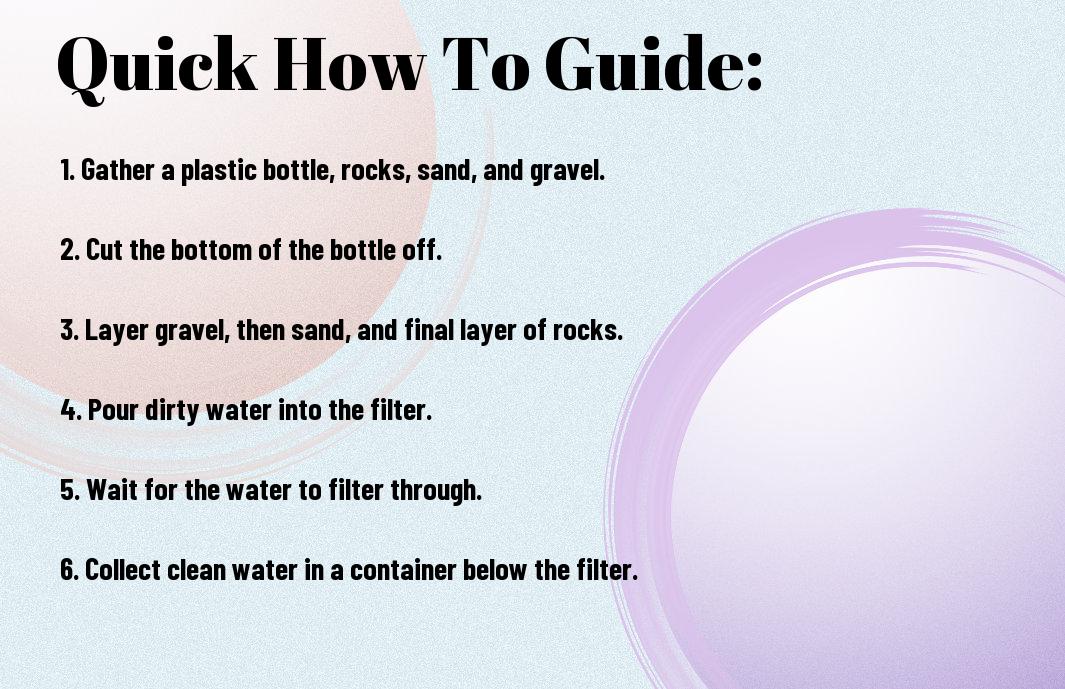Sand is a key component in creating a simple camping water filter that can effectively remove impurities from creek or river water when you’re out in the great outdoors. By incorporating sand and gravel layers in a specific arrangement, you can make a DIY filter that will provide you with clean and safe drinking water during your camping trip. Follow these easy steps to create your own sand and gravel filtration system!

Understanding the Importance of Water Filtration
Why Clean Drinking Water is Essential for Camping
Water is crucial for your survival, especially when you’re out camping in the great outdoors. You need clean drinking water not just to stay hydrated but also to maintain your overall health and well-being. Dehydration can lead to fatigue, dizziness, and even more serious health issues if left untreated. Clean water is crucial for cooking, washing dishes, and personal hygiene as well.
Risks of Unfiltered Water
Clearly, not all water sources in the wilderness are safe for consumption. Drinking untreated water from rivers, lakes, or streams while camping can expose you to harmful bacteria, parasites, and viruses. These contaminants can cause various illnesses such as diarrhea, vomiting, and in severe cases, even waterborne diseases like giardia or E. coli.
Another risk of consuming unfiltered water is the presence of sediment, dirt, and other impurities that can affect the taste and appearance of the water. These particles not only make the water unpalatable but can also clog your camping gear or water containers, making it harder for you to stay clean and hydrated.
Choosing the Right Materials for Your Filter
Selecting the Best Sand and Gravel for Filtration
Now, when it comes to choosing the best sand and gravel for your filtration system, you want to make sure you select materials that are clean, free of debris, and properly sized. Look for coarse sand and gravel that will effectively filter out impurities from the water. Avoid using fine sand, as it can clog up your filter and reduce its efficiency.
Other Essential Components: Containers, Tubes, and Valves
To ensure your camping water filter works efficiently, you’ll need to gather other important components such as containers, tubes, and valves. These items will help you create a system that allows water to flow through the filter, removing contaminants along the way.
This will help regulate the flow of water through your filter and allow you to easily access the filtered water for drinking or other uses.
Tips for Sourcing Affordable and Reliable Materials
This filter is simple to make with basic materials, many of which you may already have or can easily obtain. To make sure you source affordable and reliable materials, consider the following tips:
- Look for sand and gravel at a local home improvement store or garden center.
- Consider using leftover containers, buckets, or PVC piping for the filter setup.
- Check online marketplaces or classified ads for discounted or secondhand materials.
Essential to remember is that you can get creative with your filter materials if needed. Any clean and durable container can work as the base for your filter, as long as it can hold the sand and gravel securely.
Designing Your Simple Camping Water Filter
How to Create an Effective Filter Bed
Camping requires a simple and effective water filter. To create an efficient filter bed, you need to ensure proper layering of materials. Start with a layer of small rocks or pebbles at the bottom to prevent clogging. On top of this layer, add a thick section of sand to trap finer particles and impurities. Finally, top it off with a layer of gravel to support the sand layer and provide a stable base for the filter.
Factors to Consider for Optimal Water Flow
- Consider the size of the filter bed – larger beds allow for more contact time between the water and the filtering materials.
- Regulate the flow rate of water to prevent overflow and ensure thorough filtration.
Simple camping water filters can be highly effective if you consider a few key factors for optimal water flow. By adjusting the size of your filter bed and controlling the flow rate of water, you can improve the efficiency of your filtration system. Perceiving the importance of these factors will help you design a more reliable camping water filter.
Designing for Ease of Use and Maintenance
Any camping equipment needs to be user-friendly and easy to maintain, especially a water filter that you rely on for clean drinking water. Design your filter with accessible parts that can be easily disassembled for cleaning and maintenance. This will ensure that your filter remains effective throughout your camping trip.
Assembling Your Filter
Unlike purchasing a ready-made water filter, assembling your own sand and gravel filtration system can be a rewarding and educational experience. It allows you to understand the process of water purification while being cost-effective and environmentally friendly. Here is a step-by-step guide to building your filter.
Step-by-Step Guide to Building Your Filter
| Step | Instructions |
| 1 | Gather Materials: Collect a plastic bottle, fine sand, coarse gravel, a piece of cloth, and activated charcoal. |
| 2 | Cut the Bottle: Cut the bottom of the plastic bottle and make a small hole in the cap. |
| 3 | Layer the Materials: Place the cloth at the bottom, followed by layers of activated charcoal, fine sand, and coarse gravel. |
| 4 | Secure the Layers: Make sure each layer is tightly packed to prevent mixing and ensure effective filtration. |
| 5 | Test the Filter: Pour dirty water into the bottle and observe the filtration process. |
Tips for Ensuring a Secure and Leak-Free Assembly
- Check for any gaps or loose layers in your filter system that could cause water to bypass the filtration materials.
- Ensure that the cap of the bottle is sealed tightly to prevent leaks during the filtration process.
Clearly, the key to a successful sand and gravel filtration system lies in the secure assembly of the materials. Any gaps or loose layers can result in untreated water seeping through, compromising the effectiveness of the filtration process. Assume that a tightly packed and leak-free filter will guarantee clean and safe drinking water for your camping trip.
Common Mistakes to Avoid During Assembly
LeakFree assembly of your water filter is crucial to its functionality. A common mistake to avoid is not securing the layers of sand, gravel, charcoal, and cloth properly, leading to water passing through without adequate filtration. Make sure to follow the step-by-step guide diligently to prevent any leaks.
Common mistakes during the assembly process can include rushing through the layering of materials, not compacting each layer tightly enough, or overlooking the importance of a tightly sealed cap. Taking your time and paying attention to detail will ensure a reliable and leak-free filtration system.
Testing and Maintaining Your Filter
Once again, it is crucial to regularly test and maintain your sand and gravel filtration system to ensure that it is effectively purifying your drinking water while camping. Testing the filter’s effectiveness, understanding factors that may affect its performance, and conducting routine maintenance tasks are all crucial for optimal function.
How to Test Your Filter’s Effectiveness
There’s a simple way to test your filter’s effectiveness while camping. Fill a clean container with water from a questionable source, then filter it through your sand and gravel filtration system. Taste the filtered water and compare it to the original source. If there is a noticeable improvement in taste and clarity, your filter is working effectively.
Factors Affecting Filter Performance and Longevity
While using a sand and gravel filtration system is a cost-effective and efficient way to purify water in the great outdoors, there are factors that can impact the performance and longevity of your filter:
- The quality of the sand and gravel used in the filter
- The water turbidity and level of contaminants
- The frequency of filter use and maintenance
For instance, using low-quality or contaminated sand and gravel can reduce the filtration efficiency of your system. Thoroughly cleaning the filter after each use and replacing the filtering materials when necessary will help maintain optimal performance.
Regular Maintenance Tasks for Optimal Filter Function
Filter maintenance is crucial for ensuring that your sand and gravel filtration system continues to provide clean drinking water while camping. Regular tasks include:
- Cleaning the filter components with clean water
- Inspecting the sand and gravel for signs of wear or contamination
- Replacing the filtering materials as needed
Optimal filter function relies on consistent maintenance to prevent clogging and bacterial growth, so make sure to follow a regular maintenance schedule to keep your filter in top condition.
Troubleshooting Common Issues
Dealing with Clogged Filters and Slow Water Flow
To ensure your sand and gravel filtration system works effectively, you must regularly check and clean the filter. If you notice a decrease in water flow or clogging, you can try backwashing the filter. To do this, simply reverse the flow of water through the filter to dislodge any trapped debris. Another option is to carefully remove the sand and gravel layers and rinse them with clean water before reassembling the filter. This can help restore proper water flow and filtration efficiency.
Addressing Contamination and Filter Failure
Any signs of contamination in your filtered water, such as an unusual taste or odor, indicate filter failure or incorrect setup. In this case, you should stop using the filter immediately to prevent potential health risks. Inspect the filter components for any damage or wear and tear that may be causing the contamination. You may need to replace the sand and gravel layers or even the entire filter system to ensure safe and clean drinking water.
Avoiding contamination is crucial for maintaining the effectiveness of your sand and gravel filter. Make sure to properly disinfect and store the filter when not in use, and always use clean water sources for filtration. Regularly inspecting the filter for any signs of wear and addressing contamination issues promptly can help prolong the lifespan of your camping water filter.
Solutions for Common Problems and Errors
Now, if you encounter persistent issues with your sand and gravel filtration system despite regular maintenance, it may be time to reassess the filter setup. Check if the layers of sand and gravel are properly arranged and not compacted, as this can hinder water flow. Additionally, ensure that the inlet and outlet tubes are connected correctly and free from blockages. Proper setup and maintenance are crucial for optimal filter performance.
This simple camping water filter offers a cost-effective and efficient way to obtain clean drinking water in outdoor settings. By troubleshooting common issues and addressing them promptly, you can enjoy safe and filtered water during your camping adventures. Remember to stay vigilant and proactive in maintaining your filter to ensure its effectiveness when you need it most.
Summing up
With these considerations in mind, you now have a simple and effective method for creating a camping water filter using sand and gravel. This DIY filter is a great way to purify water from natural sources when you’re out in the wilderness, providing you with cleaner and safer drinking water. Remember to follow the steps carefully to ensure the best results and always prioritize your health and safety when filtering water for consumption during your outdoor adventures.
